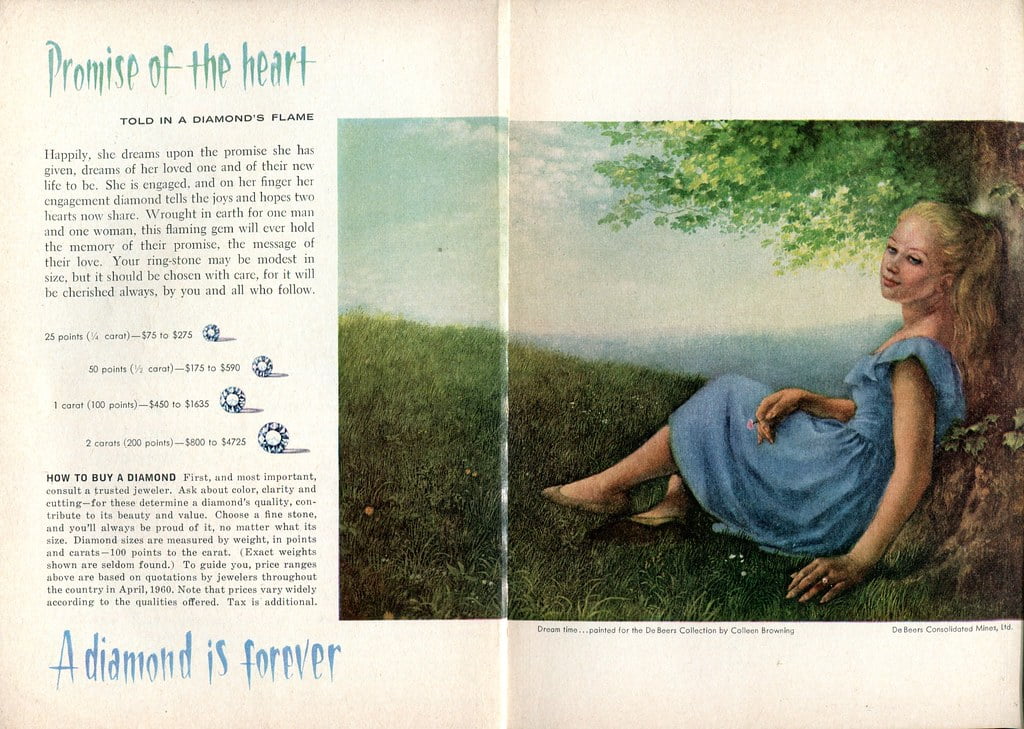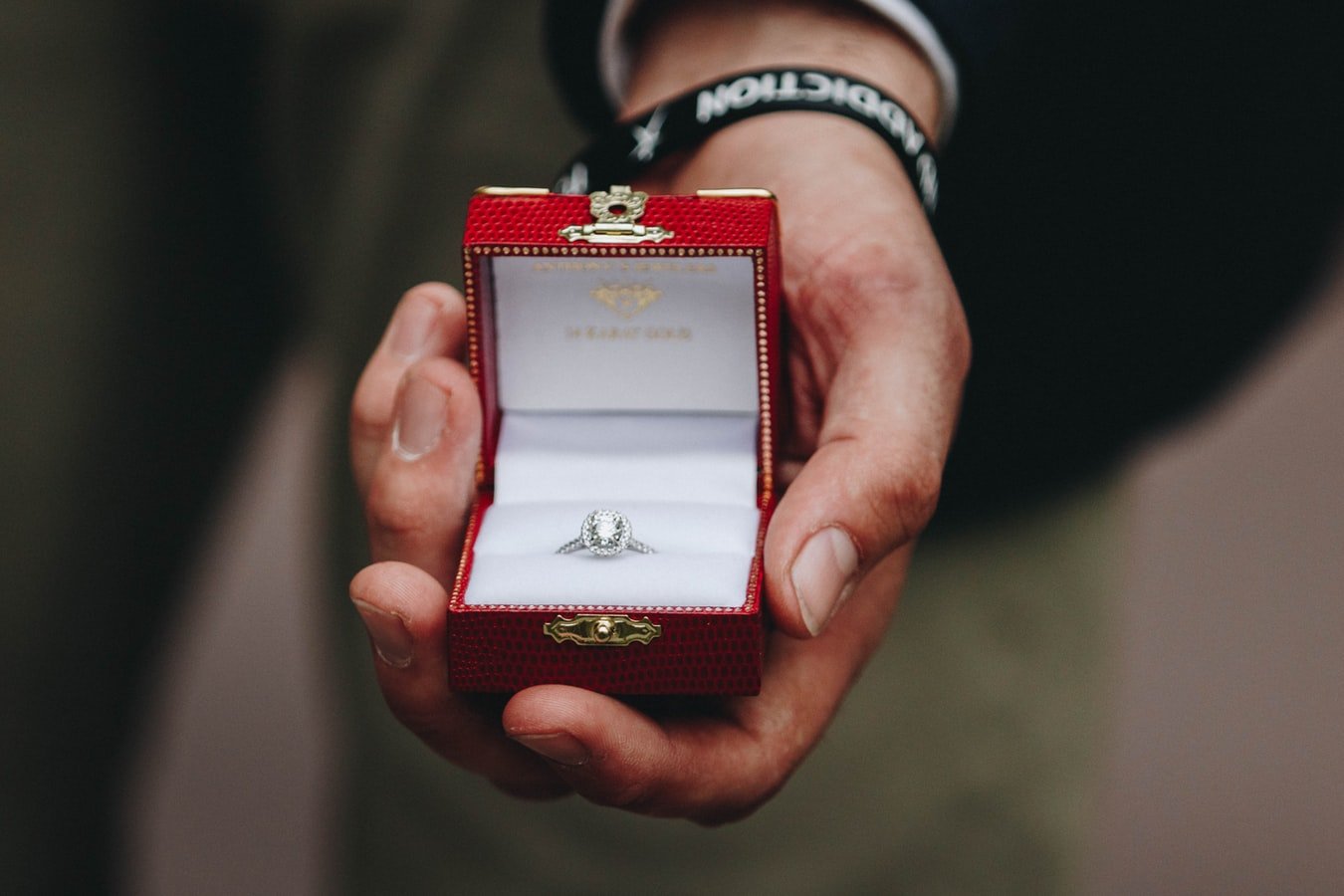Diamond engagement rings are given as gifts in movies and books, and the phrase "Diamonds are a girl's best friend"seems to have always been there. Many people believe that from time immemorial, proposals have been made using a diamond ring. But there is another version: engagement rings with diamonds gained popularity only in the 20th century thanks to an advertising campaign by De Beers. We checked whether this is actually true.
“We’ve all been fooled into believing that you need a diamond to get engaged,” “We buy engagement rings because that’s what the diamond mining company wanted us to do.” such headers have English-language articles telling the story of the popularity of diamond engagement rings. The authors of the articles claim that diamonds became popular only thanks to the advertising campaign of the mid-20th century, and advertisers came up with the phrase “A diamond is forever” so that no one would resell diamonds and the stones would not fall in price.
By the beginning of the 20th century, the tradition of proposing with a ring was already quite widespread, but for a long time stones could be any. For example, Prince Albert gave to Queen Victoria for her engagement in 1840, an emerald ring shaped like a snake. They were popular and other stones - rubies or sapphires.
And although countsthat one of the first engagement rings with a precious stone known in history was still with a diamond (with its help, Archduke Maximilian of Austria proposed in 1477), until the end of the 19th century, diamonds were quite rare stones, and their production was not very widespread. Diamonds were then found mainly in India and Brazil, with annual production reaching only a few pounds. However, in 1870, giant diamond mines were discovered in South Africa, and tons of them could now be mined. For British investors who have invested in production, immediately arose threat: if diamonds flood the market in such quantities, they will simply lose value.
Later, in 1982, American investigative journalist Edward Epstein reconstructed the story that was happening at that time in the diamond market. Diamond miners united and created De Beers Consolidated Mines, Ltd. (now known as De Beers), having obtained an almost complete monopoly on the production of diamonds and their prices, and began to operate in different countries under different names. While the value of precious metals such as gold or silver depended on economic conditions and the market, diamonds continued to gradually increase in value. By 1938, diamonds had also become a fairly popular stone for engagement rings. Although, according to the BBC, then only 10% of brides received diamond rings.

The Great Depression in the United States changed everything. Demand for diamonds is strong fell. Although even without the depression, demand was falling all over the world, because diamonds were an expensive product with no practical value, and their purchase was beginning to be considered a meaningless gesture of wealth. But the fall of the American market was an even more serious threat. In Europe, diamonds were less popular - in Germany, Austria and Spain the tradition of giving engagement rings was weaker; in England and France they were considered items of aristocratic luxury, and besides, war was brewing there. Therefore, the American market, which then accounted for about three-quarters of diamond sales (although these were mostly small stones), became for De Beers priority.
And then De Beers turned to the American advertising agency N.W. Ayer to make Americans want to buy diamond engagement rings again. The agency had to figure out how to sell stones whose value was already greatly exaggerated, stones that Americans did not want to buy and could not really afford.
After studying the diamond market in the United States, N.W. Ayer decided that the most successful strategy would be to concentrate on engagement rings. The agency proposed romanticizing diamonds: the larger the diamond, the more pure and serious love it will symbolize. Men who bought rings had to choose them based on this logic, and women began to think that the diamond was an integral part of the engagement.
Agency start promote diamonds through new media - mainly through cinema and movie stars. There were also photo shoots, radio talks, publications in newspapers and magazines, lectures about diamonds in schools, and there were even plans to involve the British royal family in the campaign. During the campaign, diamonds were featured on the pages of magazines by engaged celebrities, and were worn by actresses on the silver screen and at social events.
But the campaign really took off in 1947 with the slogan “A diamond is forever.” His came up with it copywriter N.W. Ayer Mary Frances Gerety. Although a chemistry class would have taught us that diamonds can be damaged, the idea of eternity coupled with the notion of romantic love that marriage promises was very successful. That same year, the phrase became the official slogan of De Beers.
This slogan was supposed to hint: if you buy a diamond, eternal love awaits you. And if not, then there will be no eternal love. Already in 1951, reporting on his work, Ayer wrote De Beers: "Jewelers now tell us: 'A girl is not engaged until she has a diamond engagement ring.'" That same year, eight out of ten American brides received a diamond engagement ring.
Later successful advertising campaign became spread throughout the world, adapting to new conditions. For example, in Japan, diamond engagement rings were promoted as an established Western tradition. And this it worked: Japan is still one of the largest markets for diamond jewelry.
Although the slogan itself was invented by N.W. Ayer in order to increase demand for diamonds in the US, subsequently idea The idea that diamond rings are passed down from generation to generation could be used to prevent the market from becoming flooded with oversold items. Otherwise, the statement that diamond engagement rings became popular thanks to the De Beers advertising campaign is mostly true. An important role was also played by the fact that at the beginning of the formation of this tradition, De Beers was the main player in the market (although now this is no longer the case), having an almost unlimited monopoly on setting prices and regulating demand for diamonds.
Mostly true
- Edward Jay Epstein. Have You Ever Tried to Sell a Diamond?
- Vox Media + Netflix. 'Diamonds, explained' (episode)
- Diamonds: Articles of Interest #11 (podcast)
- How an Ad Campaign Invented the Diamond Engagement Ring
- Why 'A Diamond is Forever' has lasted so long
- How Diamonds Became Forever
- The Surprisingly Recent History of the Diamond Engagement Ring
If you find a spelling or grammatical error, please let us know by highlighting the error text and clicking Ctrl+Enter.







